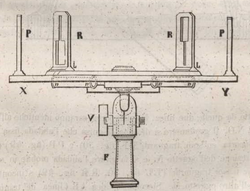

The graphometer, semicircle or semicircumferentor is a surveying instrument used for angle measurements. It consists of a semicircular limb divided into 180 degrees and sometimes subdivided into minutes. The limb is subtended by the diameter with two sights at its ends. In the middle of the diameter a "box and needle" (compass) is fixed. On the same middle the alidade with two other sights is fitted. The device is mounted on a staff via a ball and socket joint. In effect the device is a half-circumferentor. For convenience, sometimes another half-circle from 180 to 360 degrees may be graduated in another line on the limb. [1]
The form was introduced in Philippe Danfrie's Déclaration de l’usage du graphomètre (Paris, 1597) [2] [3] and the term graphometer was popular with French geodesists. The preferable English-language terms were semicircle or semicircumferentor. Some 19th-century graphometers had telescopic rather than open sights. [4]

Le Nôtre's La theorie et la pratique du jardinage ('The theory and practice of gardening'), published in 1709, described the use of the graphometer in transferring geometric shapes from garden plans onto landscapes at a large scale.
